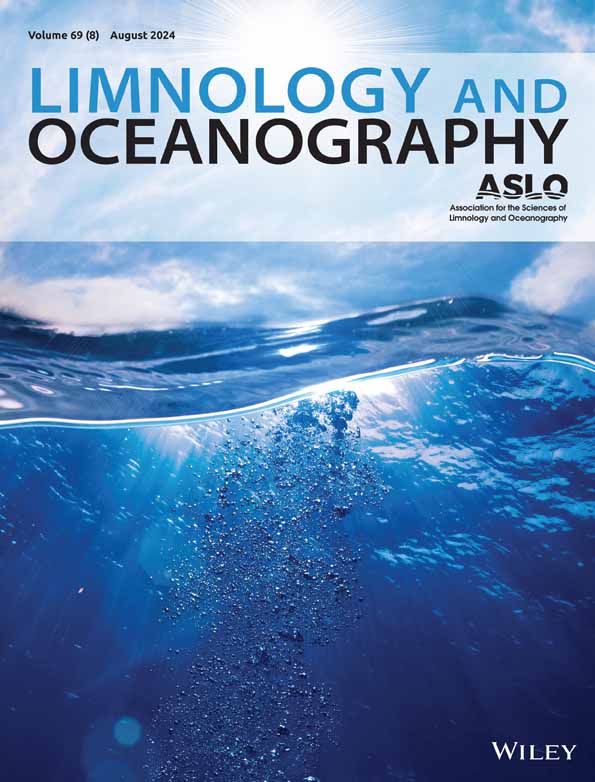细菌叶绿素揭示了河口缺氧和无氧光合固碳作用
IF 3.7
1区 地球科学
Q1 LIMNOLOGY
引用次数: 0
摘要
细菌叶绿素是由需氧无氧光合细菌和无氧光合细菌产生的光合色素。然而,海洋环境中氧化还原条件的来源、降解和影响尚不清楚。本研究对长江口水体中Bchls的分布进行了调查,探讨了Bchls的成因、退化及其对环境的响应。结果表明,河口内表层水体的总细菌叶绿素a (TBchla),包括细菌叶绿素a (Bchl a)及其降解产物细菌叶绿素a (Bphe a)均高于底部水体,微生物证据(鞘单胞菌科)表明,需氧无氧光合细菌是TBchla的主要来源。外河口底水TBchla升高,紫色硫菌(Chromatiaceae和Ectothiorhodospiraceae)是主要贡献者。海底和表层沉积物中Bphe a浓度与海底溶解氧水平呈显著负相关,而表层沉积物中Bphe a与海底和表层海水的盐度差异呈正相关(ΔS),这表明Bphe a可以作为缺氧和水体分层的有用指标。无氧光合细菌对固定碳的贡献预计将显著增加,在扩大缺氧条件下,100年后可能达到浮游植物固定碳的16%。这些发现确立了Bchls作为缺氧和水分层的可靠指标,并为重新评估全球缺氧海岸系统的碳固定提供了框架。本文章由计算机程序翻译,如有差异,请以英文原文为准。
Bacteriochlorophyll reveals estuarine hypoxia and anoxygenic photosynthetic carbon fixation
Bacteriochlorophylls (Bchls) are photosynthetic pigments produced by aerobic anoxygenic photosynthetic bacteria and anoxygenic photosynthetic bacteria. However, the sources, degradation, and influence of redox conditions in marine environments remain unclear. This study investigated the distribution of Bchls in the Changjiang Estuary to evaluate their origins, degradation, and environmental response. Results showed that total bacteriochlorophylls a (TBchla ), including bacteriochlorophyll a (Bchl a ) and its degradation product bacteriopheophytin a (Bphe a ), were higher in surface waters than in bottom waters in the inner estuary, where microbial evidence (Sphingomonadaceae ) identified aerobic anoxygenic photosynthetic bacteria as the dominant source of TBchla . In contrast, the outer estuary exhibited elevated TBchla in bottom waters, with purple sulfur bacteria (Chromatiaceae and Ectothiorhodospiraceae ) as the primary contributors. Significant negative correlations between Bphe a concentrations in bottom seawaters and surface sediments and the dissolved oxygen levels in bottom waters, along with a positive correlation between Bphe a in the surface sediments and the salinity difference between bottom and surface seawaters (ΔS ), suggest that Bphe a may serve as a useful indicator of hypoxia and water stratification. The contribution of anoxygenic photosynthetic bacteria to carbon fixation is expected to increase notably, potentially reaching 16% of phytoplankton carbon fixation after 100 years under expanding hypoxia. These findings establish Bchls as reliable indicators of hypoxia and water stratification and provide a framework for reevaluating carbon fixation in global hypoxic coastal systems.
求助全文
通过发布文献求助,成功后即可免费获取论文全文。
去求助
来源期刊

Limnology and Oceanography
地学-海洋学
CiteScore
8.80
自引率
6.70%
发文量
254
审稿时长
3 months
期刊介绍:
Limnology and Oceanography (L&O; print ISSN 0024-3590, online ISSN 1939-5590) publishes original articles, including scholarly reviews, about all aspects of limnology and oceanography. The journal''s unifying theme is the understanding of aquatic systems. Submissions are judged on the originality of their data, interpretations, and ideas, and on the degree to which they can be generalized beyond the particular aquatic system examined. Laboratory and modeling studies must demonstrate relevance to field environments; typically this means that they are bolstered by substantial "real-world" data. Few purely theoretical or purely empirical papers are accepted for review.
 求助内容:
求助内容: 应助结果提醒方式:
应助结果提醒方式:


